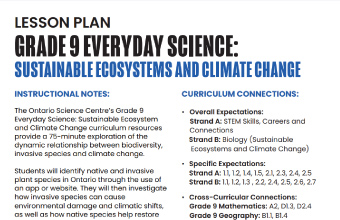Sustainable Ecosystems and Climate Change
Curriculum Connections
Strand A : STEM Skills, Careers, and Connections
| A1.1 | apply a scientific research process and associated skills to conduct investigations, making connections between their research and the scientific concepts they are learning |
|---|---|
| A1.2 | apply a scientific experimentation process and associated skills to conduct investigations, making connections between their obserA1.3 apply an engineering design process and associated skills to design, build, and test devices, models, structures, and/or systems |
| A1.4 | apply coding skills to investigate and to model scientific concepts and relationships |
| A1.5 | apply their knowledge and understanding of safe practices and procedures, including the Workplace Hazardous Materials Information System (WHMIS), while planning and carrying out hands-on investigations |
| A2.1 | design an experiment or a prototype to explore a problem relevant to a STEM-related occupation, such as a skilled trade, using findings from research |
| A2.3 | analyse how the development and application of science is economically, culturally, and socially contextualized, by investigating real-world issues |
| A2.4 | apply scientific literacy skills when investigating social and environmental issues that have personal, local, and/or global impacts |
| A2.5 | analyse contributions to science by people from various communities, including communities in Canada |
Strand B : Biology
| B1.1 | assess impacts of climate change on the sustainability of local and global ecosystems, describe local or global initiatives for combatting climate change, and identify solutions to address some of the impacts |
|---|---|
| B1.2 | assess impacts of climate change on communities in Canada, including First Nations, Métis, and Inuit communities |
| B1.3 | investigate and explain how sustainable practices used by various communities, including First Nations, Métis, and Inuit communities, reflect an understanding of the importance of the dynamic equilibrium of ecosystems |
| B2.2 | explain how naturally occurring phenomena, including the cycling of matter and the flow of energy, contribute to the dynamic equilibrium within and between ecosystems |
| B2.4 | investigate factors and processes, including biodiversity, air and water quality, soil health, and succession, and explain how they contribute to ecosystem sustainability |
| B2.5 | explain the effects of various human activities on the dynamic equilibrium of ecosystems |
| B2.6 | identify and use various indicators of climate change to describe the impacts of climate change on local and global ecosystems, and analyse how human activities contribute to climate change |
| B2.7 | explain how sustainable practices related to the cycling of matter and the flow of energy can be applied in agricultural innovations |
